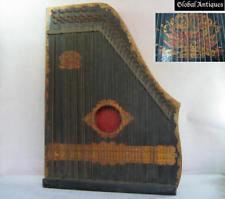 | ||
Similar Rudi Knabl, Anton Karas, Heinz Gamper, Simmaniduo, Werner Bochmann | ||
The guitar zither (also chord zither, fretless zither, or harp zither) is a musical instrument consisting of a sound-box with two sets of unstopped strings. One set of strings is tuned to the diatonic, chromatic, or partially chromatic scale and the other set is tuned to make the various chords in the principal key of the melody strings.
First patented May 29, 1894 by Friederich Menzenhauer (1858-1937), the guitar zither came into use in the late 19th century and was widely mass-produced in the United States and in Germany by Menzenhauer and later by Oscar Schmidt Inc.
The 1902 Sears catalog touted the Deweylin Harp — a type of fretless zither — as "...the wonder of the age," and "...the greatest musical instrument that has ever been placed before the public." These mandolin-guitar-zithers purported to combine three instruments for the price of one.
A form of psaltery and member of the family of chordophones, the guitar zither is closely related to the Autoharp. It differs from the concert zither in not having a fretboard and from the Autoharp in not having a mechanical process for blocking chords.
The name guitar zither is apparently derived from its sound, as the concert zither is more closely related to the guitar, in performance method, and in physical form, than is the guitar zither. A closely related instrument, the mandolin zither (or mandolin harp) has doubled strings in unison courses producing a more mandolin-like sound.
